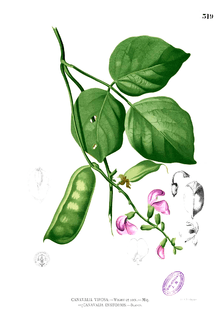Canavalia
| Canavalia | |
|---|---|
 | |
| Canavalia sericea | |
| Scientific classification | |
| Kingdom: | Plantae |
| (unranked): | Angiosperms |
| (unranked): | Eudicots |
| (unranked): | Rosids |
| Order: | Fabales |
| Family: | Fabaceae |
| Subfamily: | Faboideae |
| Tribe: | Diocleae[1] |
| Genus: | Canavalia Adans.[2] |
| Species | |
|
about 50, see text | |
| Synonyms[2] | |
|
Clementea Cav. | |
Canavalia is a genus of flowering plants in the legume family (Fabaceae) and comprises approximately 48[3] to 50[4] species of tropical vines. Members of the genus are commonly known as jack-beans. The species of Canavalia endemic to the Hawaiian Islands were named ʻāwikiwiki by the Native Hawaiians. The name translates to "the very quick one"[5] and comes from the Hawaiian word for "fast" that has also been appropriated into the name "Wikipedia". The genus name is derived from the Malabar word for the species, kavavali, which means "forest climber."[6]
Uses
Several species are valued legume crops, including common jack-bean (C. ensiformis), sword bean (C. gladiata) and C. cathartica. At least the first makes a beneficial weed- and pathogen-suppressing living mulch.[7] The common jack-bean is also a source of the lectin concanavalin A, which is used as a reagent in glycoprotein biochemistry and immunology. The jack-bean is also a common source of purified urease enzyme used in scientific research.
The bay bean (Canavalia rosea) is supposedly mildly psychoactive when smoked, and is used in tobacco substitutes.
Ecology
Some animals have adaptations to the defensive chemicals of jack-beans. Caterpillars such as that of the two-barred flasher (Astraptes fulgerator) are sometimes found on Canavalia. The plant pathogenic ascomycete fungus Mycosphaerella canavaliae was described from a jack-bean. Introduced herbivores have wreaked havoc on Canavalia on the Hawaiian Islands and made some nearly extinct; it may be that these lost their chemical defenses because no herbivorous mammals existed in their range until introduced by humans. The usually bright pea-flowers are pollinated by insects such as solitary bees and carpenter bees such as Xylocopa confusa.
History
The genus name Canavalia was, as recently as 1913, known as Canavali.[8]
Diversity

_in_Kawal_WS%2C_AP_W2_IMG_2205.jpg)
Species include:[9]
|
|
Formerly placed here
- Dysolobium grande (Wall. ex Benth.) Prain (as C. grandis (Wall. ex Benth.) Kurz)[10]
Gallery

 Canavalia hawaiiensis
Canavalia hawaiiensis.jpg)
_(6035947049).jpg)
See also
- Thierry Bardini - researched Venezuelan jack-bean agriculture early in his career
References
| Wikimedia Commons has media related to Canavalia. |
| Wikispecies has information related to: Canavalia |
- ↑ de Queiroz LP, Pastore JF, Cardoso D, Snak C, de C Lima AL, Gagnon E, Vatanparast M, Holland AE, Egan AN (2015). "A multilocus phylogenetic analysis reveals the monophyly of a recircumscribed papilionoid legume tribe Diocleae with well-supported generic relationships". Mol Phylogenet Evol. 90: 1–19. doi:10.1016/j.ympev.2015.04.016. PMID 25934529.
- 1 2 "Genus: Canavalia Adans.". Germplasm Resources Information Network. United States Department of Agriculture. 2007-10-05. Retrieved 2010-12-03.
- ↑ Sridhar, K. R.; et al. (2005). "Biochemical and biological evaluation of an unconventional legume, Canavalia maritima of coastal sand dunes of India" (PDF). Tropical and Subtropical Agroecosystems. 5 (1): 1–14.
- ↑ Yamashiro, A.; Yamashiro, T. (2008). "Utilization on extrafloral nectaries and fruit domatia of Canavalia lineata and C. cathartica (Leguminosae) by ants". Arthropod-Plant Interactions. 2 (1): 1–8. doi:10.1007/s11829-008-9030-y.
- ↑ Pukui, M. K., et al. (1992): New Pocket Hawaiian Dictionary with a Concise Grammars and Given Names in Hawaiian. University of Hawaii PRess, Honolulu. ISBN 0-8248-1392-8
- ↑ Austin, D. F. (2004). Florida Ethnobotany. CRC Press. p. 161. ISBN 978-0-8493-2332-4.
- ↑ Caamal-Maldonado, J. A.; et al. (2001). "The use of allelopathic legume cover and mulch species for weed control in cropping systems". Agronomy Journal. 93: 27–36. doi:10.2134/agronj2001.93127x.
- ↑ Piper, C. V. 1913. "The Jack Bean and the Sword Bean." USDA Bureau of Plant Industry, Circular. No. 110. p. 29-36
- ↑ Genus Canavalia. International Legume Database & Information Service (ILDIS). Version 10.01, November 2005. Retrieved 17 December 2007.
- 1 2 "GRIN Species Records of Canavalia". Germplasm Resources Information Network. United States Department of Agriculture. Retrieved 2010-12-03.
- 1 2 3 4 5 6 "ʻawikiwiki, puakauhi". Hawaiian Ethnobotany Database. Bernice P. Bishop Museum. Retrieved 2009-03-26.
- ↑ "Canavalia galeata". Hawaiian Native Plant Propagation Database. University of Hawaiʻi at Mānoa. Retrieved 2009-03-26.
External links
- International Plant Names Index: Canavalia taxa database.
- "Canavalia". Integrated Taxonomic Information System.